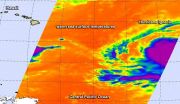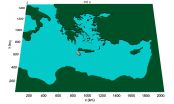NASA data shows Hurricane Ignacio's very cold cloud tops indicate quick strengthening
2015-08-27
(Press-News.org) When cloud top temperatures get colder, the uplift in tropical cyclones gets stronger and the thunderstorms that make up the tropical cyclones have more strength. NASA's Aqua satellite passed over Hurricane Ignacio and infrared data revealed cloud top temperatures had cooled from the previous day.
Ignacio strengthened to a hurricane at 11 p.m. EDT on August 26. It became the seventh hurricane of the Eastern Pacific Ocean hurricane season.
A false-colored infrared image of Hurricane Ignacio was made at NASA's Jet Propulsion Laboratory in Pasadena California, using data from the Atmospheric Infrared Sounder or AIRS instrument that flies aboard NASA's Aqua satellite The AIRS data from August 27 at 11:23 UTC (7:23 a.m. EDT) showed that cloud top temperatures had cooled within Ignacio indicating that the uplift of air within the storm was stronger than it was on August 26. AIRS data showed the strongest thunderstorms had cloud top temperatures in excess of -63F/-53C.
Forecaster Blake at NOAA's National Hurricane Center noted that "Very cold cloud tops persist near the center of Ignacio, although the overall cloud pattern is not very symmetric and no eye is present in conventional satellite data. However, microwave images show an eye beneath the cirrus clouds."
At 5 a.m. EDT (2 a.m. PDT/0900 UTC) on Thursday, August 27 the center of Hurricane Ignacio was located near latitude 12.6 North, longitude 138.5 West. That's about 1,205 miles (1,940 km) east-southeast of Hilo, Hawaii. Ignacio was moving toward the west-northwest near 13 mph (20 kph) and this general motion is expected to continue through Friday. Maximum sustained winds have increased to near 85 mph (140 kph). The estimated minimum central pressure is 985 millibars.
The NHC noted that further strengthening seems likely with Ignacio over the next couple of days as the storm moves through an area with light-to-moderate easterly shear, warm water and a moist atmosphere. Ignacio's strength is expected to peak on August 29 when the maximum sustained winds are forecast to be near 110 knots (115 mph) before weakening commences.
The current five day forecast from the NHC brings Ignacio east of the Big Island of Hawaii. Ignacio has now moved into the Central Pacific Ocean, and forecasts will be covered by NOAA's Central Pacific Hurricane Center. For updates, visit: http://www.prh.noaa.gov/hnl/cphc/.
INFORMATION:
[Attachments] See images for this press release:

ELSE PRESS RELEASES FROM THIS DATE:
2015-08-27
Researchers from the Gladstone Institutes have revealed that HIV does not cause AIDS by the virus's direct effect on the host's immune cells, but rather through the cells' lethal influence on one another.
HIV can either be spread through free-floating virus that directly infect the host immune cells or an infected cell can pass the virus to an uninfected cell. The second method, cell to cell transmission, is 100 to 1000 times more efficient, and the new study shows that it is only this method that sets off a cellular chain reaction that ends in the newly infected cells ...
2015-08-27
At a time when cancer drug prices are rising rapidly, an innovative new study provides the framework for establishing value-based pricing for all new oncology drugs entering the marketplace. Using a highly sophisticated economic model, researchers from Winship Cancer Institute of Emory University and Georgia Institute of Technology used an example of a new lung cancer drug. The study findings will be published August 27, 2015 in JAMA Oncology.
Researchers focused their investigation on a drug called necitumumab, which is awaiting approval from the U.S. Food and Drug ...
2015-08-27
Use of the 21-gene recurrence test score was associated with lower chemotherapy use in high-risk patients and greater use of chemotherapy in low-risk patients compared with not using the test among a large group of Medicare beneficiaries, according to an article published online by JAMA Oncology.
National Comprehensive Cancer Network (NCCN) guidelines recommend considering chemotherapy in estrogen receptor (ER)-positive, node-negative breast cancer for all but the smallest tumors. Several studies have suggested the 21-gene recurrence score assay (testing) is cost-effective ...
2015-08-27
Microfocused ultrasound (MFU) treatment to tighten and lift skin on the face and neck appeared to be safe for patients with darker skin types in a small study that resulted in only a few temporary adverse effects, according to a report published online by JAMA Facial Plastic Surgery.
Normal aging results in changes in the skin and underlying connective tissue. A system that uses MFU together with ultrasound visualization was developed to treat lax, aging skin. Previous clinical trials have shown the system to be a safe and effective noninvasive aesthetic treatment, according ...
2015-08-27
PITTSBURGH, Aug. 27, 2015 - Researchers have identified in an animal model the molecular mechanisms behind resilience to noise-induced tinnitus and a possible drug therapy that could reduce susceptibility to this chronic and sometimes debilitating condition. The findings by a team from the University of Pittsburgh School of Medicine were published online in the journal eLife.
Tinnitus is typically induced by exposure to loud noise and causes whistling, clicking, roaring and other phantom sounds. It is estimated that 5 to 15 percent of Americans suffer from tinnitus, said ...
2015-08-27
Each spring, powerful dust storms in the deserts of Mongolia and northern China send thick clouds of particles into the atmosphere. Eastward winds sweep these particles as far as the Pacific, where dust ultimately settles in the open ocean. This desert dust contains, among other minerals, iron -- an essential nutrient for hundreds of species of phytoplankton that make up the ocean's food base.
Now scientists at MIT, Columbia University, and Florida State University have determined that once iron is deposited in the ocean, it has a very short residence time, spending ...
2015-08-27
Women lag behind men in the lucrative computer science and technology industries, and one of the possible contributors to this disparity is that they're less likely to enroll in introductory computer science courses.
A new study of 270 high school students shows that three times as many girls were interested in enrolling in a computer science class if the classroom was redesigned to be less "geeky" and more inviting.
The results, by University of Washington researchers, reveal a practical way for teachers to help narrow the gender gap in computer science by helping ...
2015-08-27
About 10 percent of mothers experienced chronic, persistent depressive symptoms two years after Hurricane Katrina slammed into the Gulf Coast, killing more than 1,800 people, displacing hundreds of thousands and causing widespread damage estimated at more than $100 billion, according to a Georgia State University study.
While most people don't develop persistent depression after a major disaster like that, a small but significant number will, according to a study led by Dr. Betty S. Lai, assistant professor of epidemiology and biostatistics at the School of Public Health ...
2015-08-27
A team of European researchers have developed a model to simulate the impact of tsunamis generated by earthquakes and applied it to the Eastern Mediterranean. The results show how tsunami waves could hit and inundate coastal areas in southern Italy and Greece. The study is published today (27 August) in Ocean Science, an open access journal of the European Geosciences Union (EGU).
Though not as frequent as in the Pacific and Indian oceans, tsunamis also occur in the Mediterranean, mainly due to earthquakes generated when the African plate slides underneath the Eurasian ...
2015-08-27
For over a century, nitroglycerin has been used medically - particularly in the treatment of angina, or chest pain. It is a safe, cheap and effective treatment. Now, according to the latest study in ecancermedicalscience, researchers find that nitroglycerin is the latest in a series of medicines that could be repurposed to treat cancer.
The Repurposing Drugs in Oncology (ReDO) project, an international collaboration between the Anticancer Fund, Belgium, and US based GlobalCures, finds that existing and widely-used non-cancer drugs may represent a relatively untapped source ...
LAST 30 PRESS RELEASES:
[Press-News.org] NASA data shows Hurricane Ignacio's very cold cloud tops indicate quick strengthening

